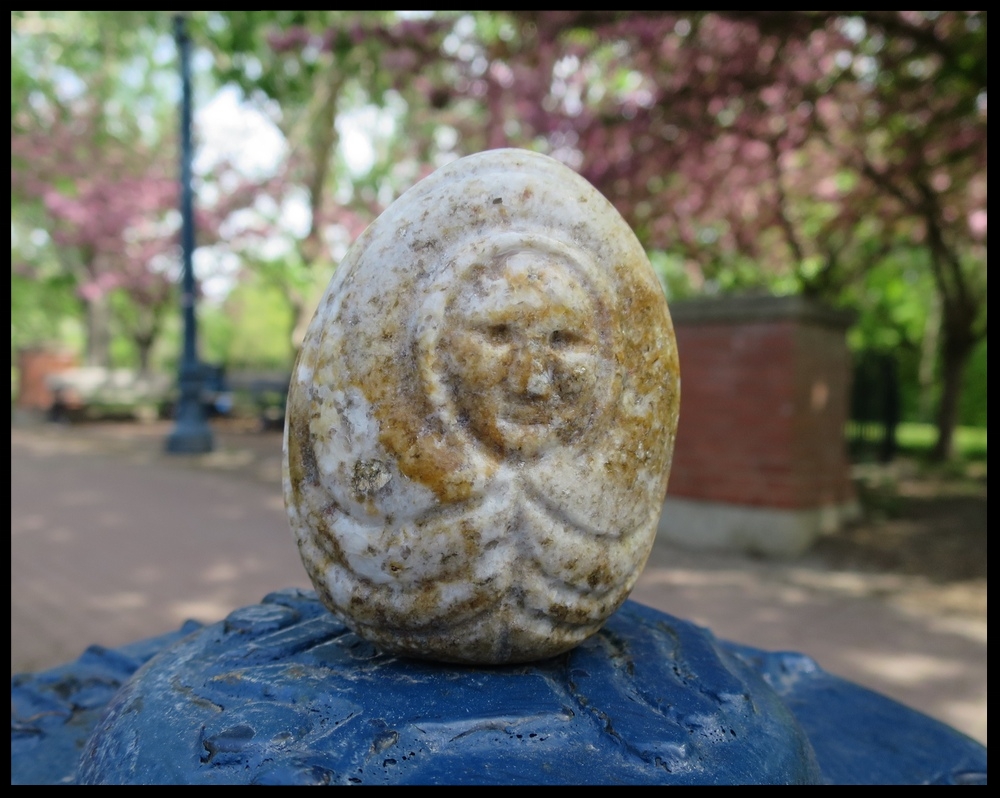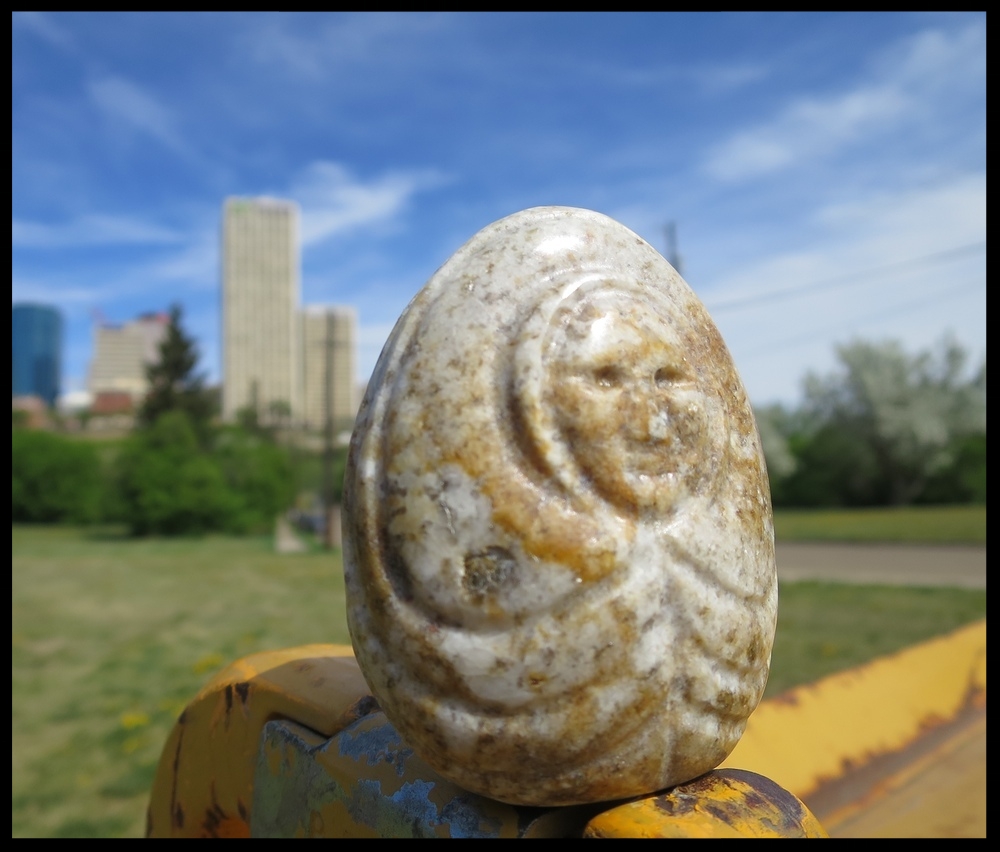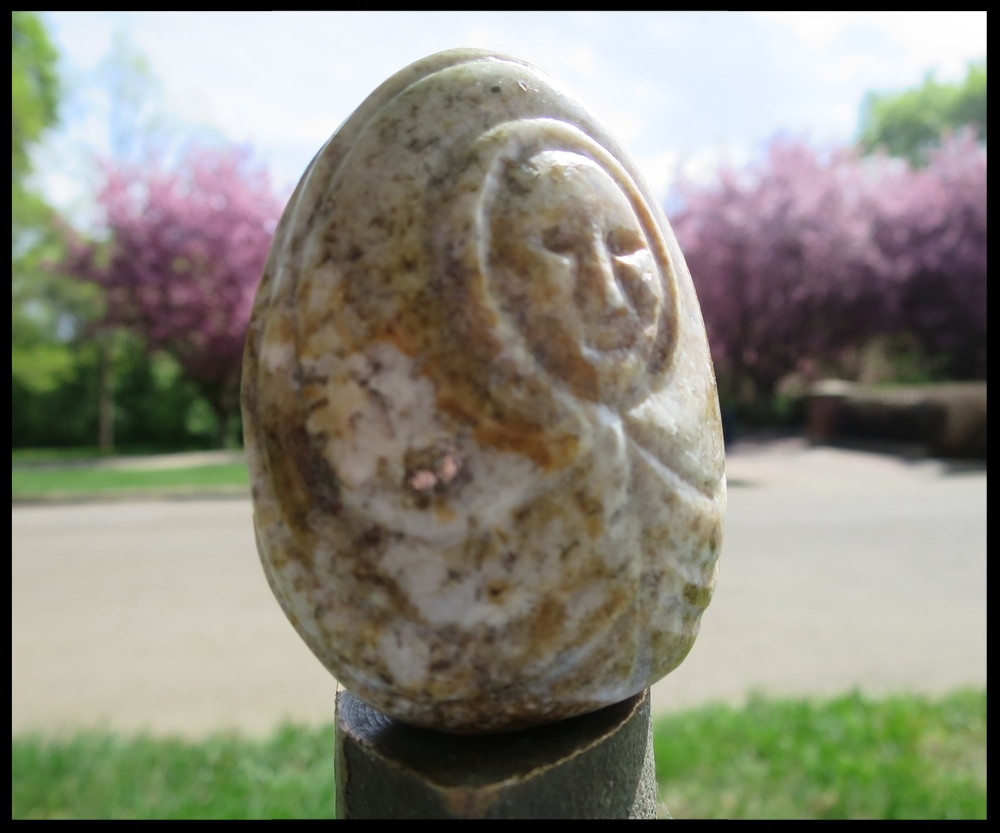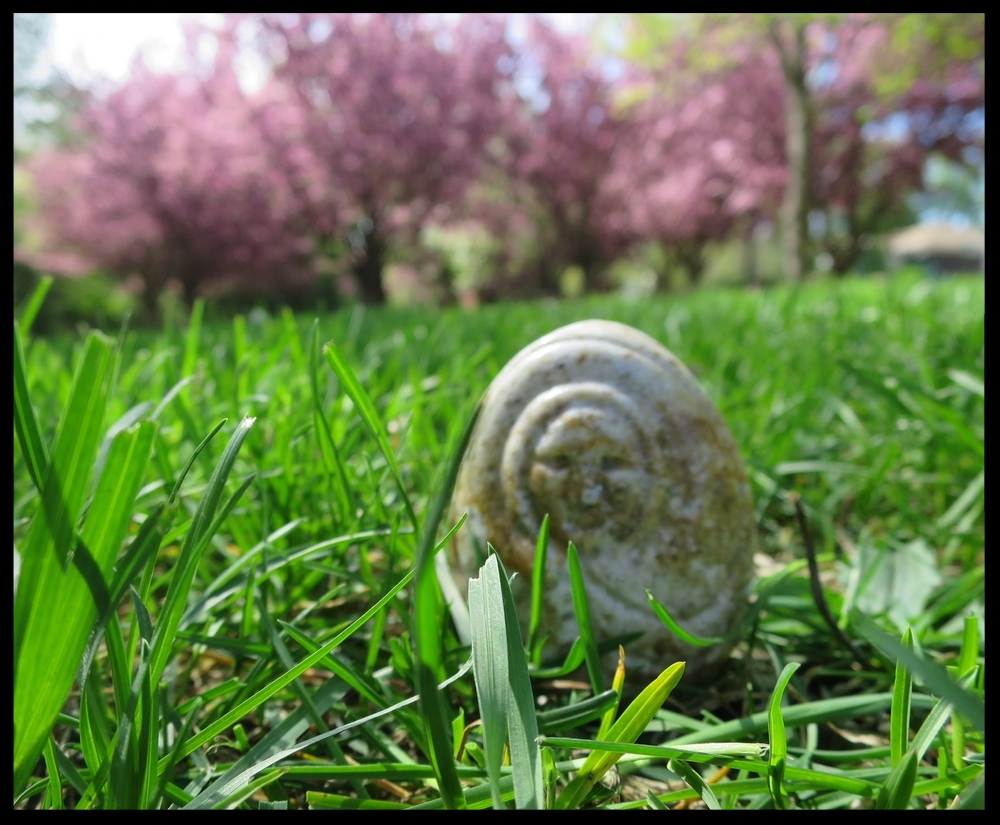The Public History Lessons of Cherry Blossom YEG-GA
The rock for this carving was first encountered by the School of One Carver during a walk with his sister in and around the environs of the famous pier attached to White Rock, British Columbia in November 2015, just before a momentous storm engulfed the Northeastern edge of the Pacific Ocean. The carving of the piece was completed on May 3, 2016 when the cherry blossoms bloomed in Irene Parlby Park during an unusually hot and sunny Spring day. Shortly thereafter, Cherry Blossom YEG-GA began travels with N.U, a dedicated student of the Liberal Arts with a deep-seated interest in Human Rights on the Global Stage, past, present and future. The carving is dedicated to the individual historical agency, accomplishments and contributions of daughters and mothers, past, present and future, especially those who remain committed to the advanced study of the Liberal Arts at the crossroads of environmental awareness and education.
Alberta Suffrage Concerns and A Northern Voyage, 2016
By Spring, 2016, N.U. had completed her own first chapter of her undergraduate education at the University of Alberta and during her first year in Arts she had already distinguished herself as dedicated student with considerable promise. N.U.'s current educational trajectory is directed towards a Political Science Major with a History Minor. The first set of vignettes from Alberta during the late Spring and early Summer reveal that she is also deeply committed to the History of Women's Rights in Canada, especially as they began to crystallize in Edmonton, more than a century ago. A journey to Alaska and the Yukon during the late Summer, moreover, led to some new historical discoveries of a different sort that will not be easily forgotten.
Mother's Day
Saturday, May 7, 2016. 28°C
We decided to hold our Mother’s Day celebrations a day early as my mother would be leaving for a conference the next day. Following an excellent meal at a local restaurant, we went for a walk just like we do every year. This year we walked along the river valley on our way to coffee and ice cream, and stopped briefly at Emily Murphy park, where Cherry Blossom YEG-GA can be seen in front of the statue of Emily Murphy herself, the women’s rights activist and first female magistrate in Canada, who was a major actor in enabling women’s suffrage and the push to have women legally recognized as “persons” during the early 20th century. Cherry Blossom YEG-GA faces forward, contemplating both how far we’ve come in empowering women and the fight towards equality, as well as the frustratingly long way we still have to go.
Alberta Legislature Grounds Reenacted, Edmonton
June 6, 2016. Around 20°C
Today, Cherry Blossom YEG-GA and I attended the reenactment of the women’s suffrage protest that had originally taken place in 1914 to celebrate the 100th year anniversary of women gaining the right to vote. After years of campaigning and protesting, the provincial government of Alberta submitted to the will of the people and passed a law on April 19th, 1916, becoming the 3rd Canadian province to allow women to vote. This picture shows Cherry Blossom in front of the crowd (in period dress) gathered to listen to the Premier’s response to the demands of the women’s suffrage movement, just as they had over 100 years ago. Despite the silliness of the reenactment, the experience brings to mind the fact that global universal suffrage is still far from reach, a notion that makes me realize how lucky we are to live in Canada, where 50% of the population is not at the political mercy of the other half (or at least not completely).
Creek Street, Ketchikan, Alaska.
8:02AM, August 16, 2016. 9°C.
Today, we stopped at the first port of our Alaskan cruise, Ketchikan AK. Ketchikan’s major industry is tourism, which is apparent from all the kitschy tourist shops occupying the majority of the tiny town. Aside from the falsefronts erected to make the town appear old, only one part of the historic town remains: Creek Street, Ketchikan’s red light district. In its heyday during the Gold Rush, this street housed over 20 brothels that serviced the fishermen and bootleggers based in the town, and had a reputation as the primary prostitution destination of the North. Creek Street is built on stilts over the river that goes through the town, an interesting architectural anomaly whose motivation dates back to the prohibition. During the prohibition, bootleggers laden with Canadian whisky would wait until high tide, and then row up to the brothels and saloons lining creek street to deliver their products during the dead of night. The brothels allegedly made more money by selling liquor to their patrons than selling "tricks", making these establishments integral to the town’s functioning and daily life, especially since the vast majority of the population was male. Today, the so-called bawdy houses have given way to storefronts and boutiques, with plaques commemorating the working girls and Married Man’s Trail (the route that married patrons of the brothels took in order to remain anonymous and assure a quick getaway) as the only reminders of its sordid past.
Totem Heritage Center, Ketchikan Alaska. Part I
12:19PM, August 16, 2016. 12°C.
During the second half of our day in Ketchikan we went to the Totem Heritage Centre. The center displays totem poles from the Haida and Tlingit cultures, and is situated in the middle of gorgeous woodland. According to our guide, the heritage center is tasked with preserving and displaying these cultural artifacts, and does so according to totem pole tradition: once a totem pole is raised it is left up until it lives out its life and falls, nourishing the earth. The Master Carvers that collaborate with the center then make new ones to replace the ones that have fallen.
Each totem pole tells a story, meant to be read from bottom to top. This one told the story of a man that was captured by Land Otters, which were shapeshifters who tricked and drowned humans according to Tlingit legend. The drowned humans would then turn into otter beings and continue to try and trick other humans into drowning and joining them.
Totem Heritage Center, Ketchikan Alaska. Part II
12:19PM, August 16, 2016. 12°C.
The second portait of Cherry Blossom YEG-GA at the Totem Heritage Center was taken in front of the longhouse and clan pole. As I learned, the clan pole was meant to signify to visitors and enemies alike which family or clan resided in that area. At this moment, Cherry Blossom obscures the “living door”, the only exit or entrance into the building. The living door was very small, so entrants would have to go in on their hands and knees, head first. This was for three main reasons, according to our guide. First, it allowed the maximum insulation of the building since there was one very small and coverable area from which heat could escape. Second, it left only one entrance to guard while the clan slept, so the least number of sentries was required. When an enemy arrived to the settlement any community member who could not fight could hide inside the longhouse. Meanwhile, the invaders would only be able to enter the home and refuge one at a time, with their weapons at their sides, leaving time for the occupants to dispatch them as best they could.
During this trip I was struck by the difference in the ways that First Nations cultures are treated and portrayed in Public History venues in Canada and the United States that I have seen. Perhaps naively, I had assumed that Canada was more respectful and inclusive of First Nations cultures due to our so-called “multi-culturalism" and national mythology regarding a "cultural mosaic". However, at least in Edmonton (Treaty Six Territory), First Nations culture is not as conspicuous or accessible, and is certainly not celebrated the way it is in Alaska. As a Canadian and resident of Edmonton, I found this aspect of my own city very disappointing and, frankly, rather shameful.
Historical Engagement Slightly Outside, Dawson City, Yukon
Friday, August 26, 2016. 20° C.
Today was my first attempt at gold panning, and where better to do it than Dawson City, where thousands of people had gathered during the Gold Rush. This river, renamed Bonanza Creek after three Yukon “sourdoughs” (the name that anyone who has survived a winter in Dawson City is awarded) first found gold in 1896, has yielded thousands of dollars’ worth of the precious metal and continues to be sluiced and panned today. The three men, for whom the towns and mountains in the surrounding areas were named, had looked into the river and seen gold ‘flour’ (gold dust) in the river banks, sparkling and well within reach. Our attempts to follow in their footsteps was a bust, and resulted mostly in splashing around in the icy, silt-filled water. We decided that the sparkling flecks of mica abundant in the dirt and mud were close enough to "the real deal". Even so, the experience is one that I won’t forget for a long time.











